Rich & Famous When You're Dead
Friday, July 31, 2009
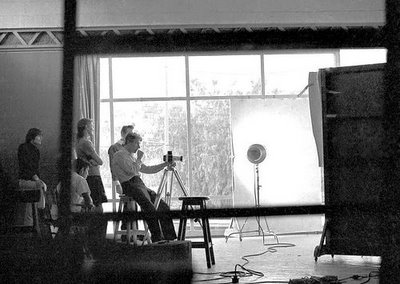
Photo, left and, below by Roberto Hall
A friend of mine has just received the Order of Canada but he does not plan to be around in our present three dimensions (and that fourth one of time) to receive it. Both of us understand that posthumous awards and posthumous recognition is worthless. I am almost sure I am going to be rich and famous when I am dead. But it is not going to do me any good. I am presently attempting my friend to spring for a new tuxedo and to get a round-trip ticket to Ottawa and collect the award “vivito and coleando” (alive with one’s tail fluttering about).
It al made me remember how fleeting fame can be for even those who deserve it.
In 1967 I arrived in Mexico City from Buenos Aires not knowing what I was going to do with my life. On one side of my family they suggested I teach Spanish and English. This I did immediately. But one of my cousins seemed to know better. Robby Miranda told me, “What do you want to do?” “I want to be a photographer but I don’t have any darkroom equipment to process the film I shoot. I would like to print my stuff, too.” He dragged me to American Photo Supply on Avenida Madero and pulled out his American Express. “Let’s get what you need.” If it had not been for Robby I would be doing something else today. I think I would be quite bored. Robby at the time was a dealer for Tefal frying pans and had contacts with large ad agencies. He arranged for me to teach English to the wife of a highfalutin account executive called Manrique. He then arranged for Manrique to get me to assist (without pay ) the best commercial photographer in Mexico and in Latin America. This was a German called Arno Brehme. His father, Hugo was better known as the man whose postcards introduced the world to the volcanoes and beautiful landscapes of Mexico. But Arno Brehme was shooting all the car ads for the biggest and most popular magazine, in Latin America. This was Life En Español.
I showed up at Brehme’s studio in upper Constituyentes, almost in the outskirts of Mexico City. The studio was built to resemble a huge airplane hangar. In this studio Brehme could shoot a car on one end, A bathroom in another and several more setups in between. Brehme had assistants, many of them but his principal one was called Seco (I believe). One day Brehme was shooting a row of Jell-O boxes. “Alex, where would you focus this 4x5 if you want to have the whole row of boxes in focus and sharp?” At 25 I thought I knew everything so I quickly answered (incorrectly), “Half way.” Brehme was much too gentle to pounce on me so with patience he explained the correct answer. In those days there were many b+w photographs produced for layouts. Brehme taught me to spot the prints (remove traces of dust on negatives which produced little white spots on the photographs) with Spotone (a series of three bottles containing a dye that penetrated the emulsion of the photograph and when dry left no trace). I remember little else of the man except for one very important incident. He showed me an artist’s rendering of a car in a garage lit by moonlight that was supposed to be an ad featuring a Plymouth Barracuda. He showed me how the moon would naturally cast the shadow in an opposite direction. He then pointed out that the artist had put the shadow incorrectly. “The idiots have no idea of the properties of light. I will light this ad and make it exactly like what they want even though it is impossibly wrong. But this is tiring.”
Shortly after he sold his studio and most of his equipment and dedicated the rest of his life to environmental issue photography. I returned to Mexico in 1989 and somehow I found him. He was in bed and looked ill. He had no idea who I was and I have little memory of what we talked about. I wanted to explain to him that he had taught me more than he would have ever suspected.
For years after I lost all contact and I don’t even know if he died or is still alive. It was only recently that I found two pictures of him (and little information on the importance of his contribution to advertising photography in Mexico). They are both taken by a photographer called Roberto Hall. The colour photograph he took in 1965 and the black and white one in 1967.
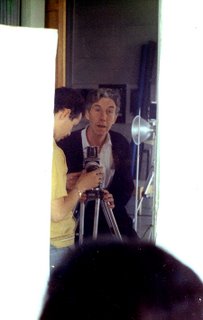
As I teach my students photography in Vancouver I note that many of them are around my age when I assisted Brehme. They are probably much better photographers than I was. And I know that many years from now I will be lucky if they remember one or two small things I might have taught them.
My friend, eager to avoid fame in the afterworld, and I, understand that this is the normal course of events. It will not make the least difference to us once we are gone. Now if I can only convince him about that tuxedo.
The Three Gifts
Thursday, July 30, 2009

In 1962 I used to walk in downtown Mexico City to four special places. One was American Photo Supply where I stared at brand new Kodak Retina Reflex cameras. I could not afford to buy their lens caps. From Avenida Madero, where American Photo was, I would walk three blocks to Avenida Venustiano Carranza where there were two magical shops with tons of used cameras (still at prices I could no afford) that featured Edixas, Exaktas, Alpas, Asahi Pentaxes, Robot Cameras, Praktinas, Prakticas and of course the cameras that were even beyond the desires of my imagination. They had Leicas. They had Leicas with reflex housings and all kinds of wonderful attachments I had no idea what they were for. These shops both had Germanic names. One was Foto Lipkau and the other was Foto Rudiger. It was in the latter where I finally was able to plunk enough money to get a camera that served me well into the middle 80s. It was an Asahi Pentax S-3. The fourth location, where I would oggle at the cameras, was the Monte de Piedad or the National Pawnshop right on the Zócalo or the main square of Mexico City. I fell in love with a Miranda there not knowing that this beauty was a dog. As for the Leicas and the even rarer Alpas I felt destined to always see one behind a counter or as a jewel, the apex of photographic technology, behind a store window.
Today I visited a friend who says he is dying. My friend was holding court in his living room assisted by a fan that moved hot air in his direction. Beside me was George Bowering, his wife, architect Bruno Freschi and my granddaughter Rebecca. My friend pointed at a laundry bag in a corner. On the laundry bag I read Jai Mahal Palace, Jaipur. It was heavy. Inside was a pristine Leica IIIf (circa early 50s). It was inside what looked like a brand new brown leather case. It is the kind of case made of special pressed leather that only Germans were able to make and which not even the Japanese were able to imitate or match. My friend pointed in my direction and said, "It's yours."
That's the first gift.
I introduced Bowering, below right, to Rebecca and told her he was Canada's first poet laureate. "George, please explain to Rebecca what that is." "In Parliament in Ottawa there is a wall with plaques. One plaque reads "Prime Minister", a second reads "Lieutenant Governor", another reads "House of Commons", a fourth reads "The Senate" and the next plaque says "Poet Laureate of Canada" and that's me." From there we had an argument as to who was the first poet laureate of England. Bowering said it was Dryden.
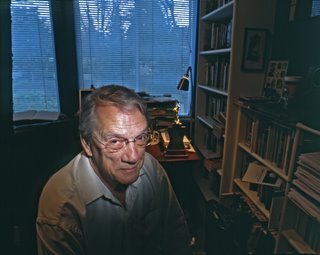
My friend said it was someone before him. Encyclopedias were checked and Dryden was confirmed. The conversation drifted to milk because out of the blue Rebecca opined that ever since milk was homogenized people have been having problems drinking milk. She pointed out that Avalon milk was not homogenized. Bruno Freschi told us he had met the original owner and that he had pushed a dream that became a prosperous reality. Bowering kicked in that Avalon milk had been delivered to him in the very neighbourhood we were in (West Point Gray) in wagons pulled by horses.
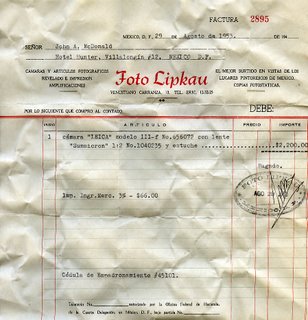

That's the second gift.
I was in a room with two great architects, a respected free-lance writer and editor, the ex-Poet Laureate of Canada and my granddaughter Rebecca. We each held our own. I was proud of Rebecca.
If she remembers some day of today, that will be my third gift even if I am not around. And unlike my friend I do want to live.
My Father's English Elegance
Wednesday, July 29, 2009

I looked in the garden and noticed today how many of my plants were collapsing with the heat and the rapid evaporation of water from the soil. My over 35 varieties of hydrangeas were the most affected. I rapidly watered around the roots. Most of my roses are in that lull after late June and part of July. Some will re-bloom in a few weeks. The only rose that is continuously in flower is Blanc double de Coubert. Her pure white flowers dazzle in the afternoon light.
But there was another rose that seemed to be impervious to the heat or to follow the dictum that roses rest for a bit about now. The rose in question is ‘English Elegance’. David Austin introduced it in 1986 and this plant, which has fully double blooms which are blush pink at the edges with tints of bright pink, salmon and orange in centres, was deemed a sickly and poor performer. Austin “de-listed” her and she is no longer sold anywhere. In my garden she has always been a good plant. While not listed as a climber she is vigorous and a de-facto climber for me. She was one of my favourites for many years until one year squirrels conspired to eat her up. A mother squirrel had her young under my gazebo roof and in the spring her young emerged and ate whatever was closest to their nest. The tender shoots of English Elegance where right there. They systematically took the bush to the brink of death. The next year a new brood of squirrels (Rosemary kept feeding them even though I told her they were bushy tailed rats) with the memory of how good the rose was to eat in their memory genes finally did her in. All I had in the summer was one brown cane.
Peter Beales, the rose expert from England suggested, “Cut that cane to the ground in the fall and pray. If things go well she will come back.” And she did! This is the second year and I am sure that in a few years English Elegance will be the vigorous climber of old. Rosemary stopped feeding the squirrels. They moved on.
When I look at my beautiful English Elegance I notice that the blooms are not perfect like in some of my Gallicas. They are messy. But they have an elegant touch like an Englishman in a Harris Tweed jacket that may be a bit worn in the elbows. The Englishman might be wearing not quite crisply ironed gray flannels. The Englishman would be smoking Player’s Navy Cut cigarettes and would be wearing an aftershave with a hint of lavender. And, of course, the elegant Englishman would be my Buenos Aires born father, whose father had emigrated from Manchester in the beginning I the 20th century. My father resemembled and talked in the manner and with the same voice of David Niven.
I am sure that my father would have never worn anything that had any of the multi colours of English Elegance. Nonetheless he might have agreed that the plant has class but would have never admitted to any resemblance to his person. It is enough that I see it. And that is satisfying.
Two Little Girls & Bubble Tea With Sheep Testicles
Tuesday, July 28, 2009

I love my granddaughter Rebecca but I have begun to realize in the last few months that more Rebeccas would never be better. If I had two Rebeccas, it would not be twice as good. It is human nature to contrast and compare. And this I have been doing every time Rebecca and her younger sister Lauren knock on the door on Saturdays. Consider that Rebecca has always eaten what is put in front of her while Lauren has a been a fussy eater since birth. She is much better now (she smells everything before daring to try it) but there is no way she will eat a Mexican tostada the way most anybody would eat it. You put the tostada in front of her which in my house is a fried tortilla with chopped meat topped with raw onions, tomato and shredded lettuce. Lauren will immediately separate all the parts carefully with her fork and eats each separately. This infuriated me on Saturday until her mother, Hilary pointed out that Lauren had gone a long way from the little girl that ate nothing. Hilary did not have to remind me that Lauren had inherited from a close relative. It was Hilary who as a very little girl cried and then had a tantrum in the dining room of the venerable St. Francis Hotel in San Francisco. A waiter in a tuxedo came to us and said, "Is there anything I can do to help the young lady?" It was my wife who answered, "Yes, if you can find her some beans and tortillas."
It is these differences between Rebecca and Lauren that make the whole experience of having two girl granddaugthers that much more enyoyable.
Today I passed by Rebecca's and invited her to have a bubble tea. Rebecca instructed me to say, "Two fresh honeydew, not powder, no milk, slush and with bubbles." She then showed me how to shake the concoction and how to pierce the top of the paper cup with an oversized straw that had a cutting angle on one side. It seems that we both share a fondness for tapioca which is what the little softly chewy pearls at the bottom of the cup are. I was about to tell Rebecca that they reminded me of sheep testicles but then I changed my mind. Age seems to be mellowing me.
We walked back and Rebecca went outside to tend to her roses and remove some of the not so fresh leaves of her hostas. I then saw Lauren scooting past in her bike with her new pink front basket. It was a delight to see her stop and hear her say, "Holá, papi."
It was a delight to notice and glory at their differences.
A Smile Almost Saves Me From Failure
Monday, July 27, 2009

Yesterday, fairly sure of myself I wrote this and today after reviewing my slides of Rebecca I might just eat that hat. There is one that almost compares to that iconic (for me) portrait of Rebecca by the agave at the MacMillan Bloedel Conservatory at Queen Elizabeth Park. Why did I fail? I have several almost certain theories.
For one the iconic portrait was a grab shot. It was a shot I saw. I saw it and checked my light meter. The exposure was 1/30 at f-2. Without a tripod that's a bit iffy. I was using a 35mm wide angle and with that lens you can get away with that 1/30 second shutter speed if you press the camera to your forehead while pressing the shutter. The look of that picture has all to do with being close to your subject with a wide angle.

This time around I decided to take a tripod so I could use slightly smaller lens openings and go for my sharpness. Not only are these picture not that much sharper but they also don't have the look of the 35mm wide angle. I opted for the very sweet Nikon F-1.4 50mm lens. That was a mistake. I had to pull back and somehow I pulled back more and my picture almost looks wider than the one with the 35mm wide angle. I also should have known better than to shoot on a sunny day. The contrast inside was strong in spite of the light filtering through the trees and the almost opaque plastic of the domed ceiling. I had taken the original day on a cloudy winter afternoon. Contrast was kinder and it opened up Rebecca's eyes and gave them that milky look I find so arresting. I guess I shall return.

If there is any saving grace in my project to repeat a favourite photograph it is that this time around I was almost saved by a smile, Lauren's smile.
Sword Excalibur & Decisive Moments
Sunday, July 26, 2009

It was sometime around 1948 and I was 6. We had moved from Martinez to Coghlan which was closer to Belgrano where my mother taught and closer downtown to the Buenos Aires Herald where my father worked as a journalist. The moving must have involved wooden crates as we had an open one in the galpón ( a shed with a metal roof) in the back of the house. With some extra boards, a broom stick and a bricks I made a car. I don’t remember what the steering wheel was but the bricks rested on other bricks on an incline so that each pair represented the gas pedal, the clutch and the brakes. For some time (my memory is not exact on this) that wooden crate was a real car. I drove the car and I was Juan Manuel Fangio the great Argentine driving champion. One day the car reverted to the crate it really was and no matter how hard I tried to use my imagination the crate was a crate. It would seem, as I look back now, that imagination and magic are killed, little by little (or suddenly as it was in my case), by growing up.
Not too long after a magician came to our school. I remember him pulling out of his throat a long string of Gillette razors. I suspect that children of my age then, would now be looking to see if they could figure out how the trick was performed. For me it was real. It was real magic, no different from what I was learning at catechism (I was getting ready to do my First Communion) where I marveled at Christ walking on water and changing water into the best wine.
For many years my medium format (6x7cm) Mamiya RB-67 has been my Sword Excalibur. I honestly believe that with it in my hand I can take very good photographs because the camera is special. I have three of them but I keep using only one. The others are for backup and or for spare parts if Sword Excalibur where to be broken beyond apparent repair. My Mamiya contains all kind of (almost) foolproof devices that prevent me pressing the shutter if the film back has not film. I can instantly change to colour or b+w film because my Mamiya has multiple backs. I own five of them.
I purchased my Mamiya sometime around 1979 and I showed it to Rick Staehling who was the art director of Vancouver Magazine. He looked at me as if I were crazy. I didn’t blame him. In comparison to other cameras of the time like the 35mm SLRs and even the 6x6 Hasselblads my Mamiya looked like a camera on steroids. It is its very heft that has made my relationship with it to grow in time to the point that I now believe that I cannot possibly take a bad photograph if I give the Mamiya all my effort and imagination.
But that Mamiya has a few shortcomings which I will argue, up and down, are the reason it is such a good piece of equipment. I have to think of every photo I take because its 120 format means I will only get 10 pictures. Film is expensive so I am extra careful. This has meant that through the years I have developed a photo/Scottish mentality of making sure everything is to my satisfaction before I press the shutter.
It is a big and heavy camera that more often than not has to be tethered to a studio light system. I need to check the light with a flash meter. I have to be fussy and fuss around. This does not mean that when I have to I cannot set up that camera and one light in under three minutes and take the picture of a busy actor or politician in the allotted 8, 9 or 10 minutes!
Where the Mamiya seems to fail (and I am not all that sure about that!) is in its inability to shoot quickly, from the hip (as they say) and capture moments with an extemporaneous quality that smaller cameras are good at.
Much has been said and written about Henri Cartier-Bresson’s dictum that one must wait for the decisive moment to happen and to be ready for it. I believe to the contrary. I believe that decisive moments can be hurried along by the photographer. A case in point, I explained it here where I rang the bell at a door and ran back in wait of the person who would open it. I use this principle in most of the photography that I do. But I will admit that when things happen (wonderful unexpected things) I do my best to notice them most of the time! Sometimes I can photograph them or I simply set it up. It many not be all that extemporaneous but it will do for me.
Switching from my Mamiya to any of my Nikons or Pentaxes must feel (to those who own guns) like letting go of the AK-47 and picking up a .22 caliber pistol. I feel like those Nikons and Pentaxes are toys. And treating them like toys I tend to take many pictures that seem eminently forgettable. One of the reasons is that these cameras almost feel alien to me. I don't use them much.
Thanks to my interest in taking pictures of my granddaughters (the hate it when I suggest we go to my studio to take some portraits with the Mamiya or I carry out the lights to the garden) I have been using my two Nikon FM-2s and one Nikon FM with some sporadic success. They are compact and light and I have a whole gamut of lenses but I seem to use mostly the moderate wide angle 35mm lens. Because I tend to use ISO 100 Ektachrome or Plus-X in b+w I find myself using maximum lens openings and slowish shutters speeds like 1/30 second. The pictures are pleasant but often they have their technical flaws. Sword Excalibur provides me with pictures that to my ey have few if any technical flaws. I guess one has to get used to the trade-off and accept that candid pictures can have charm.
There is one picture that is not in the least candid. I posed Rebecca and had her move up and down (ever so slightly) and then swing her face from left to right (ever so slightly). I instructed her to look at the camera with a cold seriousness. She rose to that request and provided me with this photo that I repeat here. I took it at the MacMillan Bloedel Conservatory at Queen Elizabeth Park when she was 7. I love how it looks like it may have been taken in Mexico with the beautiful blue agave behind her. I love the no-nonsense look of her little button-down blouse.

I will freely admit here that I used Photoshop to lighten the sparkles in her eyes. I am not the purist that some people might think I am. For me this is the most perfect photograph of Rebecca that I have ever taken and when I look at it I grieve in that I may not take a picture like that again.
As a photographer who harps about creating decisive moments I have a better chance of taking a picture like that since I don’t have to wait for it to happen.
That brings me to the meat of today’s blog. I decided on Friday and told Rosemary that we were going to return to the MacMillan Bloedel Conservatory on Saturday and take pictures of Rebecca and Lauren by the agave. I took two cameras. One was a Nikon FM-2 loades with Ektachrome 100G (my favourite colour slide and transparency film). I took another camera. It is a camera I have not used in many years. It is an extremely heavy Nikon F-3 with an attached motor drive. In its heyday it was a serious peace of photographic equipment. Thinking of my 20s I loaded it with Kodak Tri-X.
Rebecca tried to thwart me every step of the way yesterday. She absolutely refused to wear a beautiful dark blue Mexican dress that her mother wore a few times at about her age. There was lots of shouting, “I hate dresses! I will not wear it, it’s too big for me and I cannot bend over as my breasts will show!” In the end with a bit of pleading and logic she relented and wore it. I found a little top from Oaxaca for Lauren in our Mexican trunk.
When Rebecca stared at my camera yesterday she would watch my shutter finger. As soon as she saw me about to press she would give me a wishy washy smile. Many exposures were ruined. I told her to stop it. She didn’t. I then covered my right hand shutter finger with my left hand and that was the end of it!
I have come to change my mind a bit about my Mamiya Sword Excalibur. Perhaps that beautiful no-nonsense-I-mean-business Nikon F-3 does have some of its qualities. It is not too late in my photographic career to discover it and perhaps even profit from it. As I held that Nikon F-3 I felt a bit of magic. It was exciting. No, I wasn't driving that car/crate. I had not gone back that far in time. But I was feeling that electrical pulse going through me. I was taking pictures again just like I had done those many years ago. The weight in my hand, the decidedly loudish ( a most expensive sounding sound) motor drive. I was in control of the decisive
moment.
"Tune in" here to see the results in a few days.
Queso Tipo Roquefort & Breakfast (In Bed) With The NY Times
Saturday, July 25, 2009
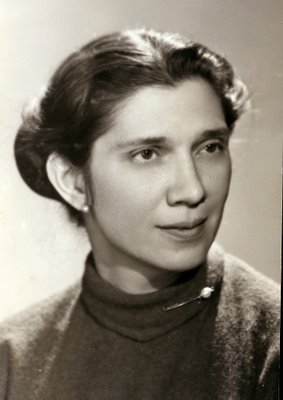
I have never really liked smelly cheeses even though I cannot live without cheeses in general and I do adore some strong ones. It is all my mother’s fault. In Buenos Aires I remember that her favourite spread for her morning toast was “queso tipo Roquefort”. Even then she would point out to me that this was a very good Argentine imitation of her favourite cheese from the Combalou caves of Roquefort-sur-Soulzon. She sometimes combined it with jamón crudo as Argentine (at least then they were sticklers in not stepping on the toes of some of their European cousin’s patents) called Prosciutto di Parma. While I can blame my mother for ruining my possible enjoyment of smelly cheeses she did instill in me the idea that breakfast was a most important meal.
It was my grandmother who further taught me that breakfast was supposed to also be fun. She would smile as she would dip her toast (slathered with butter, strawberry jam and peanut butter) into her very sweet café con leche. Breakfast was never breakfast without her sweets.
For many years in Vancouver breakfast was a sit down affair at the dining room table. It became difficult to coordinate one breakfast with our different schedules and our two daughters’schools. But we managed.
Nineteen years ago it all changed when my friend Mark Budgen suggested that instead of spending money and gas trying to secure the NY Times at a newsstand that it would be better if I obtained a daily delivered subscription. There was an enterprising Korean gentleman who would drive every day from the US border and deliver the paper in most of the lower mainland. He retired in Shaughnessy and the business of delivering the paper was taken over by the Globe & Mail.
Breakfast, with some few exceptions has been in bed since. Rosemary and I roughly alternate the days one of us goes down to prepare breakfast at around 6:30. My grandmother would not smile and my mother would have found it odd that I would have the previous evening’s cold pizza for breakfast. Pizza for breakfast is a rare occurrence but about 10 years ago we would often have bacon on Sundays.
It is simple now. Rosemary drinks decaf and on a few days fo the week I make her cream of wheat with brown sugar. Of late my roses have been happy with her as they share her bananas’ potassium. Rosemary eats the inside with brown sugar and I cut up he peels and sprinkle them around my roses who grow all that much better with that potassium.
My breakfast is a very large mug of very strong tea (made from loose tea in a large ball) a glass of juice (V-8 or apple, Rosemary likes grapefruit) and two Venice Bakery scissor rolls that I bake in the oven until they are very dark.

I don’t spread that tipo Roquefort on my bread but like my mother I enjoy those morning papers (the other one is the Vancouver Sun). And so does Rosemary. It seems that the day has not really begun until we silently (we never talk at breakfast) have our breakfast in bed and read our papers. Both of us follow the exploits of Rex Morgan.
Chieftains Block The Shortcut That Was
Friday, July 24, 2009

My city has changed a lot since I first got to explore it in 1975. I was working for Tilden Rent a Car on Alberni Street. Before I was “promoted” to counter clerk I washed cars and jockeyed them to other Tilden locations includign the one at the airport. I had never driven automatic cars so my first experience with rental cars at Tilden was that I drove them with the right foot on the gas and the left foot on the brake. This did not work well and the car would jerk around. Nobody bothered to correct me. I guess they thought I drove like that. Eventually I caught on that one used only one foot.
It was driving to the airport that I discovered the few shortcuts that a city can have when it is a grid of north/south and east/west streets. Those shortcuts can be diagonals like Kinsgsway (impossible now with all those traffic lights) or Puget. Fir and Hemlock are shortcuts at certain times of the day when one wants to avoid “the little old ladies” that cross Granville as one of my buddy car jockeys used to comment. But on Sunday Granville is an easier way as Hemlock allows parking so only one lane each way is in operation. And we knew not to speed on the Arthur Laing Bridge. It was a Federal jurisdiction and tickets were much more expensive. It was at that time that learned to open any locked car in under three minutes with a coat hanger wire. Renters constantly lost keys or locked them inside.
Ultimately it was my knowledge of back alleys and how to avoid bad traffic intersections that allowed me on any given day to get to places more quickly (yet driving at the speed limit) than most people. Once, none of that helped except for that back alley savvy. Rosemary’s Audi 5000 (the one that was supposed to accelerate all on its own) would not do so even with my help. I found myself stranded on Cambie and 7th Avenue. I managed to get home (41st and Granville) by driving the Audi through most of the back alleys that I knew, in reverse gear, which was the only operational gear of the Audi’s automatic transmission which had given up the ghost.

And there was another time when I arrived late to a party. It was around 1980 and when going to town and specifically to West Van or North Van I used to take a shortcut which avoided the congested afternoon traffic to the North Shore. This was the road that hugged the waterfront and began in Gas Town and and paralleled the CP Rail tracks and ended on Georgia, right before Stanley Park. The road no longer exists now as it is all high rises and is traffic calmed. But back in 1980 taxi drives knew the trick. There were a few speed bumps one had to be careful and every once in a while a train would block the way.
What blocked my way for close to an hour was not a train but the loading of British battle tanks (Chieftains) that had arrived to our harbour in a British Navy freighter. They were being loaded on to flat cars and railed to the Canadian Forces Base at Shiloh, Manitoba. NATO and particularly the German Army liked to have maneuvers in Shilo as the terrain imitated the plains of the Ukraine which is where the world thought WWIII might have to be fought.

It was a few weeks ago that driving to the Shaw Tower (I was going to be interviewed by Fanny Kiefer in her Studio 4 TV) where I almost could not recognize where I was. There were no landmarks left of the old road. The CP barge was long gone as were the railroad tracks. I could not even discern the ghosts of those tanks that had made me fume about arriving late to that party. I am only glad that I did have a camera so that the fading memory of those Leopard tanks (they weren’t Leopard tanks) that crossed my path 29 years is a memory of actual events. I remember telling my host, “I am late because some Leopards crossed my path.” Alas, they were Chieftans and if Kinsgsway is impossible now, Puget is a shortcut that still works just fine.
Eadric Silvaticus & Cloves In My Garden
Thursday, July 23, 2009

Without knowing anything about this new David Austin English Rose I bought it and planted it in the centre rose bed. I knew it had rugosa parentage and this meant that the rose would be tough, floriferous and disease-free. Because I put it into the ground in early spring it did not bloom normally as it would have if I had planted it the year before. It has made up for lost time by blooming right now in big clusters of beautifully droopy almost messy clusters. The scent is intense and unique (read below). I go to the garden and smell my roses and I cannot figure out why more people do not do this. Why is it that they have also not discovered the wonders of the Fantastic period of music as the music of the 17th century is sometimes called? Or why is it that more people do not collect, as I do, as many versions of Gerry Mulligan playing My Funny Valentine? I guess the enjoyment is more intense simply because it is a lonely one.
Shropshire rose grower, David Austin has this to say about Rosa 'Wild Edric':
This is an unusually tough and reliable rose that will thrive even under difficult conditions and is not only suitable for the border, but it is ideal for semi-wild planting or for hedges. Its flowers start as attractively pointed, purple-pink buds. They gradually open to a semi-double flower of deep velvety pink with shades of purple and mauve, exposing a bunch of golden-yellow stamens that contrast with the colour of the petals. The overall fragrance is strong and delicious but interestingly, with a little investigation, a marked difference between the fragrance of the petals and the stamens can be detected. The latter is pure clove, whereas the former is classic Old Rose with hints of watercress and cucumber.
Wild Edric was a Saxon Lord in Shropshire, who was said to have married a fairy Queen. He reproached her one day and she disappeared. Legend has it that his ghost is still be to seen searching for her in the hills. 4 ft. x 4 ft. (1.2 m x 1.m).
The Wikipedia has this to say about Wild Edric and it seems that it can also be written Eadric:
Eadric the Wild or Eadric Silvaticus was a leader of English resistance to the Norman Conquest, active in western Mercia, 1068-70.
Arts Coverage Versus Yoga On A Bed Of Daisies
Wednesday, July 22, 2009

Today I went to my second GVPTA Advocacy Committee meeting. I am not a member of the GVPTA (Greater Vancouver Professional Theatre Alliance) but I was an interested observer. All the different branches of the arts community in Vancouver, be they theatre, dance, music, opera and the visual arts are suffering from the combined blows of the economic downturn and the retreat of conventional media to the lifestyle topics of food, health and style. The GVPTA Advocacy Committee is attempting to address the problem and to find a solution.
A well known news anchor at the Corporation told me that arts coverage is below their indicated spectrum of activity. My gracious and keen friend of the arts, Paul Grant will be history by the end of July at the CBC. The taking of the package at the Corporation precludes a de facto disappearance of the position held by the person retiring. Until the folks at that Corporation can figure out a new name for arts coverage or in a method to circumvent the prohibition of bringing it back, we will not have any.
It was three months ago that I went to see a brilliant play at a well known theatre company’s venue. It was a Thursday opening. I noticed that our city newspaper’s critic was not there. I later found out that the critic had broken a leg. There was no review on the Saturday paper and this, I suspect, adversely affected attendance and the company must have lost money. A Wednesday review was too late to save the day.
I pondered on how the fortunes of a theatre company depended on that one review. To be fair, a competing weekly paper, while being published on a Thursday (too late to review a play for the Saturday), does post reviews, as they are written, on its web page. But as I see it, with the fading of radio arts coverage (can Jian Ghomeshi be the one-size-fits-all arts reporter?) and the consideration that the making of tofu burritos and doing yoga while gardening on a bed of daisies is covering the arts in a newspaper, our local arts organizations have to find another way of making what they do known to the public.
I called a local and very importan marketing manager of a Vancouver arts organizaton and I pressed to him my idea of something that I would call (in a most preliminary manner) a Vancouver Arts Web Hub. He was enthusiastic and immediately suggested that the key for its success would lie in a central core with a paid and independent editor, who would hire writers to write credible criticism, previews and essays on the arts.
To make a very long story short we had a preliminary meeting and a steering committee is being put together. So far we have (I am the independent observer) Charles Campbell (former editor of the Georgia Straight, books editor of the Tyee, arts editor and opinion page editor for the Vancouver Sun), Amir Ali Alibhai (artist and Executive Director of the Alliance For Arts And Culture) and Nini Baird (as far as I know the only American woman to have received the Order of Canada and a powerful promoter of the arts). There are a few others who will join. The first mandate is to obtain funding as the complexity of a web site that would also incorporate all the participating web sites of Lower Mainland arts organization) will require money. The plan is to launch the site (a soft launch seems a realistic one) in the spring.
Charles Campbell will probably be the independent editor suggested by the marketing manager I cited above. Max Wyman has informed me that he would be a keen contributor in writing for the Vancouver Arts Web Hub. I have in mind essays that would attempt to lure classical ballet enthusiasts to try modern dance or essays that would explain the importance of acting in opera or, why baroque music is not that much different from new music of the 21st century. It is my feeling that arts coverage should include more than previews and reviews.
As an example I made the conscious choice of taking my 11 year old granddaughter to see the Playhouse presentation of the Electric Theatre Company’s Studies in Motion- The Hauntings of Eadweard Muybridge. It had full nudity which didn’t bother Rebecca in the least. She is now enthusiastic about theatre. I exposed her to her first Shakespeare play, The Comedy of Errors. She now wants to go to more Shakespeare. It will probably not be Othello but All’s Well That Ends Well.
I have always felt that the media had the obligation in helping us become aware of the benefits of living a life surrounded by all the arts of which we have so many in Vancouver. And they rarely show us ways of inducing our younger ones to accompany us.
Simon Ogden at today’s GVPTA Advocacy Committeee Meeting astounded us by telling us that in the Canadian theatrical community Vancouver is seen as cutting edge! Who would have known? We who live here do not understand the richness of our art scene. I read in the NY Times the constant reviews of classical ballet danced by imported dancers from Russia. I compare that to the variety of dance we have in Vancouver and I do believe we have the richer one.
Charles Campbell published our proposed mandate in the blog of the Alliance for Arts and Culture here. I am quite excited at the prospect of having what in reality will be a Vancouver on line arts magazine that will incorporate also the finest arts blogs in town like Plank Magazine and Simon Ogden’s The Next Stage.
The boy with the violin in the picture above is one of the first pictures I took of violinist Corey Cerovsek when he was 14.
A Rose Is Not A Rose When...
Tuesday, July 21, 2009
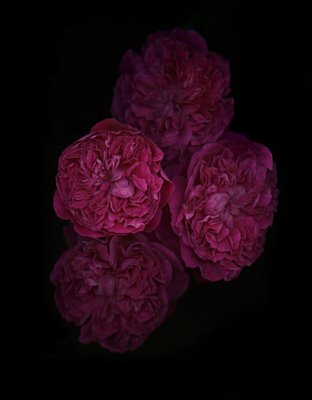
Juliet:
'Tis but thy name that is my enemy.(40)
Thou art thyself, though not a Montague.
What's Montague? it is nor hand, nor foot,
Nor arm, nor face, nor any other part
Belonging to a man. O, be some other name!
What's in a name? That which we call a rose(45)
By any other name would smell as sweet.
So Romeo would, were he not Romeo call'd,
Retain that dear perfection which he owes
Without that title. Romeo, doff thy name;
And for that name, which is no part of thee,(50)
Take all myself.
Romeo:
I take thee at thy word.
Call me but love, and I'll be new baptiz'd;
Henceforth I never will be Romeo.
Romeo and Juliet, Act 2 Scene 2, William Shakespeare
Just about anybody can quote or remember part of the above:
What's in a name? That which we call a rose
By any other name would smell as sweet.
I beg to differ in one specific exception when the rose in question happens to be called Rosa ‘William Shakespeare’.
Perhaps Shropshire rose hybridizer, David Austin, wanted to get part of the action associated with Shakespeare and roses by naming one after the bard. The rose is a beautiful but as David Austin writes about it in the Varieties That Have Been Superseded section of his book David Austin’s English Roses, New Edition, 1996:
William Shakespeare (AUSROYAL) can produce some of the finest crimson Old Roses that anyone could wish to see. Its colour ranges from crimson to purple, to violet and mauve. The growth is very strong and upright. Sadly, it has shown tendency to rust and blackspot and would not pass our stringent tests we have today. Rich fragrance. W 90cm (3ft) x H 120 cm (4 ft). Breeding: ‘The Squire’ x ‘Mary Rose’. Introduced 1987.
In 2000 Austin introduced an improved version, unpoetically called 'Shakespeare 2000' and as far as I am concerned it is not as sweet because of its name.
Ealry this spring I noticed that my William Shakespeare was languishing and it was near death. I took it out of its spot and put it into a plastic pot and placed it in the middle of my stone path were it would get full sun and bake a bit. It prospered and I was so happy! Shakespeare was not dead. It was going to survive. Had it died there would be no replacement except for Shakespeare 2000 (ugh!). But that was not to be. My Lazarus-like plant had a but and the bud was orange red. When it opened I knew it was another plant I never really cared for in spite of its beautiful name. It was Rosa ‘Ainsley Dickson’ a rose we never suspected to be salmon pink and a colour that Rosemary dislikes. I had relegated the rose to an out of the way spot around other roses. It had somehow survived. I gave the rose to my friend Paul Leisz who loves the colour.
Now if this wasn’t William Shakespeare…. I immediately went back to my rose bed and there he was, nice, strong and vigorous and, in my garden, all the rose that its maker says it isn’t!
When a rose is called William Shakespeare, it has to be more than a rose. It has to be a special rose that both Rebecca and I especially love. We saw the display of a brand new Shakespeare 2000 in our rose bed. We liked the blooms but we are snobs and as far as we are concerned only William Shakespeare (the rose) is the real William Shakespeare.
The picture you see here is what Rosa 'William Shakespeare' looked like late afternoon today when I scanned it.
Maurice Chevalier Would Approve
Monday, July 20, 2009

The only male in our house besides this blogger is Rosemary’s cat, Toby. I have my female cat Plata and when Hilary comes over with her two girls I am pleasantly surrounded by women. I can think of nothing better. Such was my fear that my paradise would be destroyed by the advent of a little boy that I went as far as informing Hilary (she was pregnant) that if she had a little boy I was going to disown her. I never had to exercise my threat as Lauren was born, 7 years ago. To watch two little girls (Rebecca is now not that little at almost 12) play in our garden is a delight that makes all the hours of garden work seem all worthwhile.
Last Saturday I caught Lauren in a serious mood while she was sitting on one of our lawn chairs. This is not characteristic of her as she smiles and laughs all the time. But I had photographed a serious (always serious for my photos) Rebecca minutes before so perhaps Lauren was just imitating her. Minutes after, the two girls began to dance and Rebecca gave Lauren some ballet lessons. I snapped with my Nikon FM loaded with Kodak Plus X and felt in my 20s again with the excitement of taking pictures just for fun.

The girls and Hilary returned today and for once Rosemary did not get her way and I made very thin pancakes. Rosemary says that pancakes can never feel like dinner. I tried a new recipe of baking bacon in the oven with lots of brown sugar. I served it with the pancakes. The girls used fruit syrups (we have several kinds) while Hilary decided on the Argentine dulce de leche.

This time around Rebecca taught Lauren how to make cartwheels after both sat in a children’s small plastic pool to cool off. I took the trio home and as I drove back I counted my three blessings and all those other women in my life. Toby and I are in our glory.
Fractals, Nodal Points & The Beauty Of Imperfection
Sunday, July 19, 2009

Laney’s node-spotter function [from Idoru] is some sort of metaphor for whatever it is that I actually do. There are bits of the literal future right here, right now, if you know how to look for them. Although I can’t tell you how; it’s a non-rational process.—William Gibson, August 1999
One of the more memorable incidents in Gibson’s 2007 novel Idoru involves a young woman who plans to have a video communication with a woman in Tokyo. She carefully plans what she is going to wear. Once she decides she buys her virtual clothing on the net. Her computer dresses here in these perfect designer clothes. Anybody in the room during the communication would mention something to the effect that the emperor is not wearing clothes. But the woman in Tokyo sees a beautifully dressed woman in an elegantly furnished room.
It is here that Gibson, left, hits on one of his nodal points in which he observes that literal future now. Part of the woman’s computer program lays fractal dust on the surfaces of the virtually real furniture. The dust makes the room look lived-in and authentic.
That scene in Idoru has haunted me and especially now when I look at the photo assignments of my students. Their work is perfect. The imperfect human skin pore has been banished with the use of proprietary (every one of my students has a secret and personal process for this) Photoshop methods involving “healing tools”, “patch tools”, gaussian blurs and other methods like the oddly named "diffuse glow". Photo magazines display marvelous mountain scenes reflected on a pristine lake. The viewer cannot figure out which is the reflection and which is the real scene. The colours are punchy, bright and extremely sharp. Modern computer-designed lenses, even those with plastic elements, are uncommonly sharp. That uncommonly sharp scene can then be further sharpened with the Photoshop sharpening mode.
The above reminds me of the nouveau riche inhabitants of a new development, near ours in Arboledas, called Tecamachalco in the Mexico City I inhabited in the early 70s. These folk had beautifully designed homes and brand new cars. Wood tables marred easily so huge dining room tables were laminated with Formica and then further protected by thick sheets of plate glass. Lamp shades were protected from unsightly dust by being covered by clear plastic protectors. The upholstery of their Ford Galaxies and Mustangs were covered with a thick clear plastic. The purpose of all this was eternal newness.
Anybody who has ever purchased an expensive pair of shoes or a shiny new red bicycle can attest to the disappointment of having someone step on your shoe or that first fall in the red bike and the subsequent scratch of the red paint. If anything the deterioration of the house we live in, the garden we tend, the car we drive all remind us of the corruption and subsequent death of it.
We are temporarily distracted by the perfection and youth of babies and grandchildren. We repair the dent of the car fender. We long ago forgot that the purpose of paint was to stave off the rust of metal. The car will run dent or no dent. In the dawn of computer diagnostics for cars in the late 60s, the white uniformed German technician in my Mexico City VW dealer would show me in a computer print-out, the curves of the four pistons of my Beetle. He would point out how one of the pistons was leaking gas out of the cylinder. Compression was in decline. Time was taking its toll on my shiny new car.
This search for perfection killed Glen Gould’s desire to ever play a concert for and audience. He preferred the pristine environment of the studio. That he then “corrupted” these perfect recordings with his unusual humming perhaps prefigured William Gibson’s fractal dust. As for me I like the unexpected performance of a live performance. Violins make squeaks and when I listen to one of my favourite violinists, Marc Destrubé I enjoy hearing him breathe.
Gibson with his “nodal” ability to see future trends has already predicted one which I think may happily push perfection out of the way. Soon we will see panoramics of polluted lakes in Africa and photographs of women with skin pores and dazzling droopy breasts. Men will soon show of their tire handles and the antique business will be taken over by the former inhabitants of Tecamachalco who by now have discovered the wonders of rust, marred wooden tables and furniture and the beauty of decaying plants and imperfect and aging bodies.
The second photo here is a picture I took of Norm Necemer with his original everything (including paint) fuel injected Corvette. I took the photo around 1983. I am sure that Necemer probably still owns the car and it probably is beautifully looking worse for wear.

Now if I could only make my students understand the beauty of imperfection.
An Agave, The Fairy & The Comedy of Errors
Saturday, July 18, 2009

"Time is a very bankrupt, and owes more than he's worth to season.
Nay, he's a thief, too: have you not heard men say,
That time comes stealing on by night and day?" (Act IV, Scene II), The Comedy of Errors, William Shakespeare
Rebecca and I had an exciting time at Bard on the Beach. We saw Shakespeare’s farce, The Comedy of Errors. This version was happily over the top, complete with a bear, a cock, a couple of mechanical rats and roasted, skewered mice. To almost top all that there was Christopher Gaze in drag looking like Queen Elizabeth I. But what topped it all was Christopher Gaze, below with Rebecca, as a drunk whose face is rubbed into buxom (and pregnant) Emilia’s (Colleen Wheeler) chest. It was hilarious. Best of all it was a treat to watch Rebecca have a good time.

When we returned I made thin, crustless sandwiches (cucumber, egg salad, ham and cheese), and my in family famous iced tea. We had a guest, my Mexican photo student Gabriel Beltrán who wanted to see the photos on my walls. His favourite is the first one you see here of Rebecca when she was 7. I took it at Queen Elizabeth Park’s MacMillan Bloedel Conservatory.

Four years before I had photographed Rebecca in my studio dressed as a fairy. For a long time the fairy photo was one of my favourites. I had nothing to compare it with. She looked cute and adorable. Now as I look back I see the emptiness (her potential all hidden beneath) of the little girl, too young to really have a complex personality. That complexity and that sadness of growing up shows by the time she was 7 in that photo by the Mexican agave. Lauren is rapidly approaching that age. She is 7 now and I can see the seriousness in her demeanor when she asks me questions. I have to be ready to take that picture that straddles precariously between childhood and the lost innocence of adulthood.

The polyantha rose, Rosa ‘The Fairy’, 1932 Bentall, is a cute, little and almost procumbent rose that is a late bloomer. It started blooming this week with masses of little globular flowers that grow almost in deep shade and in poor soil. It is a survivor (alas, Rebecca’s died this last winter). As I saw it today, once Gabriel left, I went to look for the fairy picture of Rebecca. While I photographed Rebecca today in her beautiful little bikini there is still more of a shock value in the agave photograph.
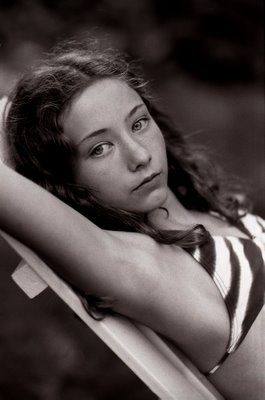

A rosy, safe and pleasant nostalgia is what I feel when I think of the fairy. I cannot wait for Rebecca to grow up. First we must watch Beau Geste together. Next a Shakespeare tragedy. The time is near.
Falstaff - Fat, Big & Red
Friday, July 17, 2009
Falstaff: If sack and sugar be a fault, God help the wicked! If to be old and merry be a sin, then many an old host that I know is damned: if to be fat be to be hated, then Pharaoh's lean kine are to be loved. No, my good lord; banish Peto, banish Bardolph, banish Poins; but for sweet Jack Falstaff, kind Jack Falstaff, true Jack Falstaff, valiant Jack Falstaff, and therefore more valiant, being, as he is, old Jack Falstaff, banish not him thy Harry's company, banish not him thy Harry's company: banish plump Jack, and banish all the world!
William Shakespeare, Henry IV, II, iv
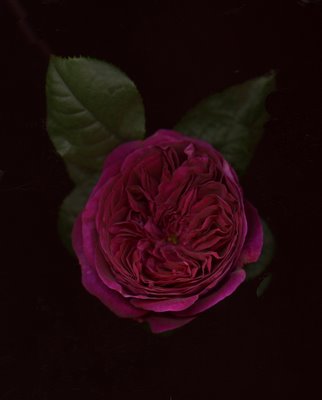
I have to admit here ignorance on all things Falstaff. I have never seen or read Shakespeare's Henry IV Part 1 or 2 so I know nothing about Falstaff from those quarters. But I have read Harold Bloom's Shakespeare - The Invention of the Human . It would seem that the time has come for me to correct this large vacant spot in my brain since Harold Bloom's favourite Shakespeare character happens to be Falstaff. And my Rebecca has fallen in love with the English Rose by that name. I obtained one for my garden this year but I overlooked buying one for Rebecca. I am trying to make amends in the best way I can. Tomorrow Rebecca and I will be going to Bard on the Beach to see The Comedy of Errors. This will be Rebecca's first Shakespeare play. I am all excited and I hope that all the action under that tent and the real farce that this play is will serve as an entry into a more serious Shakespeare. Perhaps we will both explore Falstaff the man, and add him to our list of favourites.
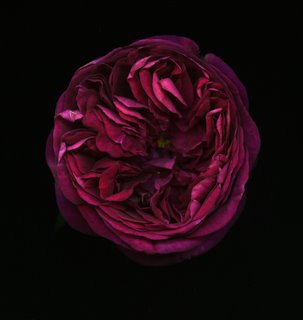
The images here are what Rosa 'Falstaff' looked like today, fat, big and red.
That Recurring Leaky Tank Problem
Thursday, July 16, 2009

Ever since I can remember there was one word problem in school which I despised since no matter how they hid its core with words it was always a leaky tank problem. So much water (gallons per minute) is going into a tub that has no stopper. So much water is going out of it (gallons per hour). The question was always the same. Will the tub stabilize, empty or overflow?
This problem is one that hits us all in finances, in mortgage payments and just about everything else. It doesn’t take a computer spread sheet to tell me that if the money going into my monthly studio does not exceed the money going out I am going to have an empty tub very soon. And so I have decided to let go of my studio in the next few months.
I can rationalize that the little work that I do in it like lawyer or businessman web portraits I can do in their offices. All I need is a blank wall and to trudge over with my lighting equipment. Those Ministers of Parliament (NDP) that hire my services every once in a while since they know I can make them look honest, incisive and intelligent will have to pay extra for me to secure a day’s studio rental. I don’t see the problem there.
Rosemary saw this coming a few years ago but kept playing around with our money because she thought (rightly at the time) that a studio is part of a photographer’s pride of profession.
For a long time a big chunk of studio money came from my arts photos for the Georgia Straight. That has stopped as the publication has found the cheaper route of either demanding handout art or expecting it staff writers to take the pictures. I don’t see that publication suddenly turning around that mandate.
If there is anything of what I do that my suffer in not having my own studio, it is the personal work that I rely on to keep me on my toes and to keep at bay the tendency of age to deaden passion.

But the personal work now is either the studio portrait of my granddaughters or my work with the undraped human body. Cases in point are these pictures of Lisa Ha, a Vietnamese/Canadian subject of mine that sporadically frequents my studio. These I took a couple of weeks ago. I like to record the change of time. I may have last photographed her about 4 years ago. The next time will probably have to be in my living room or in my garden or in her apartment. I can assert that environmental photographs can have their charm, too.

Best of all I will take my grandmother’s advice to heart, “Nadie te quita lo bailado,” Nobody can take away from you the dances that you have danced.
more Lisa Ha.
A Nightmare Of Books
Wednesday, July 15, 2009
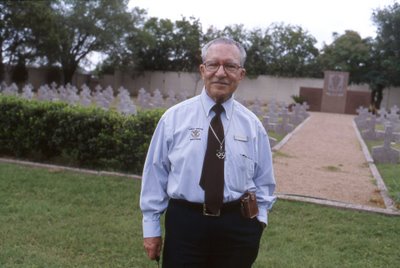
I had a nightmare last night. It was a nightmare of books. When I woke I felt I had not slept. I get these obsessive dreams every once in a while and it seems to me that since I am partially conscious I have not slept well at all.
I believe that this blog is going to be a long and meandering one. It is really based on the idea that if you are near a very good library or you are living in one (Borges would approve from his great infinite library in the sky) you would not know the existence of certain books unless you found them or you knew they were there.
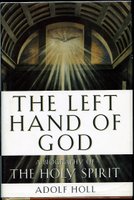
I read a lot but Rosemary absolutely refuses to buy me books for Christmas or my birthday. The only persons who have dared to present me with a book have been my eldest daughter Ale and her godfather Andrew Taylor. I don’t think that they have been entirely successful in their choices. I do believe that picking a book to read is something personal. An exception could be, to know that a friend reads all the novels of P.D. James. You check your friend’s library and you don’t spot the latest James. You can then present the book as a gift. But there is something missing here. The paradox is that while that James book is the right one you are not going to help, push, force, reveal, surprise or even disappoint your friend with a book unknown until opened as the book from nowhere.

My aunt Dorothy Rowstron, who died in her 90s in Toronto a few years ago, was an avid reader. Somewhere along I got the wrong idea as to what she read. For Christmas, for her birthday I would send her the latest Danielle Steel novel by FedEx. She always called me to thank me. It was after her death that I discovered from her son-in-law that Aunt Dorothy had an exquisite and refined taste for books and she would have never read Danielle Steel even if someone had pointed a gun at her. She was too gracious to tell me of my faux pas. Sept the illusion going until she died.

My 85 year-old first cousin (she is also my godmother) Inesita O’Reilly Kuker reads a lot. She lives in Buenos Aires. She reads in English even if her family does not. She has kept her Argentine private school English (Northlands and you have to pronounce the word with your nose up in the air!). She reads lofty stuff like the novels of Susan Howatch (Mystical Paths happens to be in my library so I know why she likes the author). They are somewhat Graham Greenish about religious men who have doubts about the canons of their faith.

For years book in English have been hard to find (particularly the ones Inesita's refined tastes would demand) and expensive. A pocket book fetches $30 US. Every time I have had the opportunity to go to Buenos Aires I take books for her. The last time one of the books was a beautiful illustrated biography of Grace Kelly. Before we flew to Buenos Aires Rosemary had left my suitcase open on the floor as she remembered stuff to put into it that would suddenly come to mind. Toby, her cat decided to mark his territory on the book. The morning before I left for Argentina I sprayed the book to no avail with all kinds of perfumes and disinfectants. I do believe that Inesita did read the book before she chucked it into the garbage. Books in English are that precious in Buenos Aires.
A few months ago Inesita fell outside her summer apartment in Punta del Este, Uruguay. She did not tell her family. When her son Georgito came to pick her up, he was shocked to see the black and blue marks on her face and her bloodshot eyes. He took her to the doctor who explained that Inesita had an eye hemorrhage orme and it would take her months to see well again.
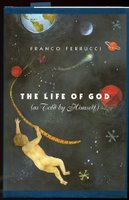
 When I found out I tried to get her family to rally and find her spoken books in the US (one of her grandsons travels). This was to no avail. They could not understand what it is to be a serious reader. Our first cousin Elizabeth Blew suggested I purchase a large-print Reader’s Digest subscription. I did not have the nerve to tell Elizabeth that Inesita would never ever read Reader’s Digest in small or large print!
When I found out I tried to get her family to rally and find her spoken books in the US (one of her grandsons travels). This was to no avail. They could not understand what it is to be a serious reader. Our first cousin Elizabeth Blew suggested I purchase a large-print Reader’s Digest subscription. I did not have the nerve to tell Elizabeth that Inesita would never ever read Reader’s Digest in small or large print! 
The solution became a simple one. I have purchased some good CD books (all are unabridged) and copied them. I mail these to Inesita and mark the envelopes as picture CDs. All have arrived without being pilfered by the sometimes notorious Argentine postal system. I keep the originals in case the copies get lost. I can copy them again. I am probably breaking some copyright law but I feel that the circumstances give me some justification.
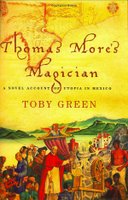
I have been sending Inesita novels by Daphne du Maurier. She is currently enjoying a Romeo and Juliet with Kenneth Branagh as Romeo and a great list of players including Judi Dench, John Gielgud and Derek Jacobi. While she initially found Frank McCourt narrating his own Angela’s Ashes a tad depressing she told me she enjoyed it in the end. What will she think of Neil Jordan's Shade? Will she appreciate John Knowles's A Separate Peace?
Enter Brother Edwin Reggio CSC who is a Catholic Brother of the Congregation of the Holy Cross. Back in the late 50s he taught me religion, theology and nudged me (not gently) into learning to play the alto saxophone for the school band at St. Edward’s High School in Austin, Texas. I have been with him of late (back two years ago with Rebecca and Rosemary when we passed by Austin, on our way to Mérida, Yucatán) and in June when I went to an all years school reunion. I took him two books as gifts. One was Toby Green’s Thomas More’s Magician – A Novel Account of Utopia in Mexico and the other book Amir D. Aczel’s The Jesuit and the Skull – Teilhard de Chardin, Evolution and the Search for Peking Man. The former book is about the most interesting Spanish/Mexican bishop, Vasco de Quiroga who traveled to Mexico just a few years after the conquest. Of Chardin I wrote here.

Brother Edwin thanked me for the books and in an e-mail mentioned he was reading it. But there was no comment that he liked it. Brother Edwin is a private man. I know he has two university degrees, one in math and the other in music. He is a photographer, a carpenter, a sculptor, he is the barber for his order, he has a job at St Edward’s University dealing with alumni affairs and all the drink and food machines on campus. He delivers the mail to the brothers, and makes the frames for all the photographs and painting in all the buildings on campus. He also feeds the squirrels. He loves to eat barbecue at that Austin institution, the County Line. He is an Olympic ring expert, he canoes and late in life learned to rappel. Besides the piano he can play any wind instrument. He is an expert trumpet player. I know so little about him.
A request to him to tell me what his reading habits were, resulted in a short mention that he did like mysteries. Does he like English mysteries or American serial killer mysteries? I don’t have a clue. He also did agree with me that it is handy to have the University library about a block away from his sleeping quarters. Brother Edwin suggested that if I wanted to get rid of my book collection that I should donate it to a school.

But is there something perverse in me trying to guess what he likes and to find books from my collection that I have read that I can share with a man that has been so important in my life?
Supposing he has enjoyed the book on Vasco de Quiroga I would surmise that the book is not part of the university library collection. He knows about the book because I knew about the book. It is that connection that fascinates me and kept me awake last night as I thought of all the books that might have some sort of mystical or religious content and yet be entertaining. Here are scans of some of the books that I re-read through the night. I would like to specifically point out Graham Greene’s Monsignor Quixote. A not-to-smart small-town priest entertains a visiting bishop and feeds him a horse steak for lunch. The bishop is so marveled by the delicious offering that he sends Father Quixote a pair of purple socks and makes him a Monsignor. With the retired and most communist former town mayor, Sancho, the pair decides to drive around Spain in a Spanish Fiat a Seat and…
Perhaps as I send books that Brother Edwin likes or dislikes he just may not take my Aunt Dorothy’s tack of not telling me that he did not like a book. I look forward, if that is the case, to finally getting to knoe a man that has been an enigma to me since I first met him in 1958.
I wonder if the nightmare will continue tonight. I could dream about Ellis Peters's Brother Cadfael mysteries or Patrick O'Brian's Jack Aubrey/Stephen Maturin series. Brother Edwin might enjoy the taciturn Native American protagonists of Tony Hillerman or would he like all the novels I have about the American Civil War? Brother Edwin is from New Orleans - a jazz biography? Has he read Umberto Eco's The Name of the Rose? There is Brian Moore's Black Robe. Then there is that novel about a pope, Anthony Burgess's Earthly Powers. On the other hand why do these books have to have a religious connection? And then...
Emma Peeles For Me
Tuesday, July 14, 2009
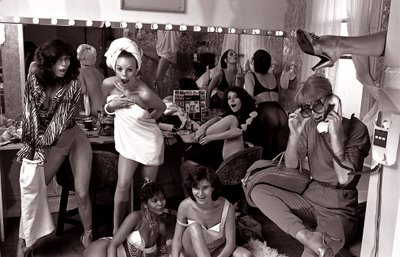
In 1967 my Argentine Merchant Marine Victory Ship, the ELMA Río Aguapey docked in New Orleans. It was December 24th. I was the only passenger. I had never spent Christmas away from my family. I felt a tad sad so I decided that the solution was to go and see a stripper on Bourbon Street. In hindsight this was a terrible idea. I walked on Bourbon Street and went into the first joint that advertised Girls! Girls! Girls! I ordered a Bourbon Whiskey figuring that was the drink that went with the territory. I sat in the front row and waited for the action. The action consisted of a fairly skinny woman who walked in in, looking quite glum. She headed for a corner and plugged in a juke box. She moved to the music like a badly oiled robot. Her face was passive boredom. I left thinking, “Is this all there is?” I woke up Christmas day with a terrible hangover.
I had to wait until 1978 when I saw my first really good stripper. It was at the Drake Hotel and her name was Emma Peele but the patrons who frequented the place called her English Anna because of her thick Cockney. She was not much taller than 5 ft and she had black hair and large beautiful eyes that smile before she even began to smile. She was terrific. The New Orleans incident became a memory I soon forgot. I became a serious ecdyciast. I had many faves and the list changed every week. But I never forgot English Anna. She was from a slightly previous generation to the lovelies you see here posing for me in the Drake Hotel dressing room circa 1982.
Not too long ago Rosemary and I were enjoying chicken at my fave fast food place in Vancouver, Nando’s on 41st Avenue and East Boulevard in Kerrisdale. It began to get noisy. We could hear some women and their children talking in a raucous Cockney. Rosemary made us move to a quieter spot which happened to be near the exit of the restaurant. We enjoyed the last of our chicken. Then the loud group, two mothers and their daughters and sons passed by us. I recognized one of the mothers but I decided to be quiet. She might not want to be recognized. As she turned around the corner I changed my mind and shouted, “English Anna!” She turned around and with that smile of hers said, “How are you Alex? I want you to meet my son…” The young boy, around 12, seriously asked me (I thought he was going to punch me), “Why did you call my mom that?” I diplomatically answered, “Everybody who has ever met your mom calls her that. It is her accent, you know.”
Tamsin Gilbert & Her Two Poet Fathers
Monday, July 13, 2009
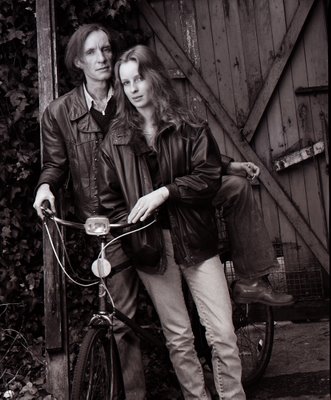
Tamsin, Born 7:10 a.m.
i will write you poems for you
i will not
write poems for you
(what a wonderful morning
you are
you are what
a wonderful morning you are)
child
when you were born
it was light
out
all was: the doctor’s white coat was
wet
shining with your mother’s blood
i saw
you
her, my girl
this girl here
doing it all
to the least
of us
& the morning
opened, yelling
the most ordinary thing in the world
Gerry Gilbert
I took the above photograph to accompany Gilbert’s poem on his daughter Tamsin and both appeared in Vancouver Magazine, May 1986. I wrote about it here
Gerry Gilbert died June 19, 2009 on the day of Tamsin’s birthday. Today I ran into Tamsin Gilbert at the Railway Club. She said, “Hi, Alex.” I stared at her even though the voice was the same and her hair was the same. I did not know who she was. She looked different. She looked different not because she was older (45 I think she told me she was) but because her face was softer. She was happier than she was when I photographed her for the second time (and the last time I saw her until today) in my former Yaletown studio on Hamilton Street (in 1986 I could afford to share a studio with a fashion photographer because Yaletown had yet to be discovered by yuppies. In 1986 I saw a resemblance between Tamsin Gilbert and Charlotte Rampling, see photograph below. Using the window lighting of my studio I tried to press Gilbert into that mold and I may have succeeded so well that I didn’t recognize today the real Tamsin Gilbert.
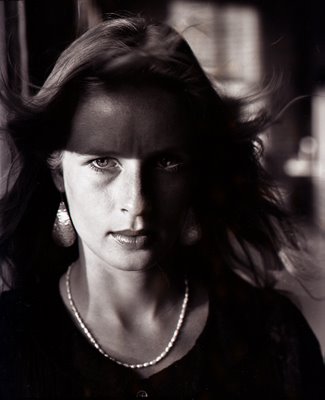
“Why are you in town, Tamsin,” I asked her. “To take Gerry with me,” she answered. She explained that her father had been cremated and she was taking his ashes home. Sometime in August a memorial service is planned and Tamsin Gilbert will spread Gerry’s ashes into the sea at Kitsilano.
Tamsin Gilbert is a much happier woman. I could discern contentment and peace in her face. When she was a baby her mother separated from Gerry and re-married poet John Newlove. At any given time in her life her father was always a poet. I wonder what is in store for Tamsin on her island home of Saltspring? One, who might be able to guess, is her daughter. After all her two grandfathers were poets and her name is Cassandra. And judging by Tamsin Gilbert’s face as I saw it today that future must surely be a rosy one.
Tracy & Gillian - Charmers They Are
Sunday, July 12, 2009
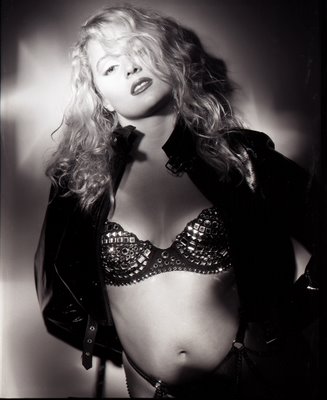
While deadheading roses today I watched my neighbours come in through the lane in their air-conditioned cars, hermetically sealed to the odors that might linger from nearby garbage bins and perhaps even afraid of breathing the air. The doors of the garage open and they drive in. There is a satisfying thud (for them I suppose) when the door slides down. Some of my neighbours’ houses are kept new and I sometime think that they could hose the interiors without affecting any of their furniture. It is all protected from the elements and even from the travails of time and oxidation. Life is clean and pure, hermetic, sanitized and safe.
I wonder what my neighbours would think of the other Vancouver that is past the lane. It is a Vancouver I have had few glimpses of in my years of working for a city magazine. I have known cops and hoods, pimps and prostitutes, murderers and rapists, coroners and judges and a few politicians thrown in. And I have met a few women whose specialty was to entertain men. Some were really good at it.
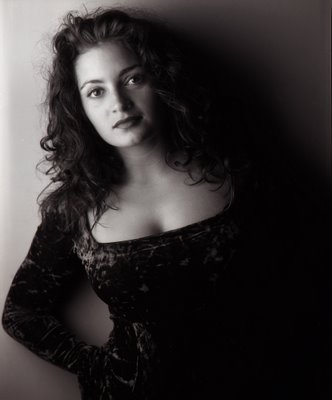
For many years I had an interest (it seems to be subsiding now) in the photography of the undraped female. Finding females to undrape is now no more difficult than finding models to not undrape. But years back in the dawn of Expo 86 it was tough. I developed a relationship with a few “directors” of stripper agencies. Through them I met some voluptuous women, some voluptuous women who were charming, and even some voluptuous women who were not only charming but delightful and ready to take it all off in a matter of seconds. Since I have always been the type of person who eases in slowly into a cold swimming pool my methods were sometimes at odds with these charmers who seemed to be in a hurry.
Every once in a while Ken would call me up and say, “Alex I have this new friend who is beautiful. You might find her interesting. I would make an arrangement to meet the interesting friend in my studio. Thanks to these charmers I honed my skills in glamour photography. I used experimental lighting methods and best of all I made some interesting friends. Here are two. The dark haired woman was called Gillian and the blonde was Tracy. The latter wore an S&M outfit that is beyond the boundaries of this blog so the two images of her here will do.

As I watched my neighbours in their spotlessly new vehicles I wonder if their entertainment ever goes beyond the micro thin layer of photons on a computer monitor or a flat-screen TV. There is a world out there that is not so clean, it may be seamy, but it is real. It has three dimensions. It has thickness. I would be flabergasted if they ever lowered their windows and asked me to smell my roses.
The girls are charmers, too.
A Beautiful Day In Richmond
Saturday, July 11, 2009

Today Rosemary, the two girls and I went to swim at Paul Leisz’s pool in Richmond. We took some gnocchi pre-cooked with a tomato and cream sauce ready for the oven so that the Parmesan would brown. Rosemary prepared a fresh salad and I made a mango smoothie/slush. Paul fired up his barbecue and he grilled smokies, baby back ribs and red peppers. For dessert we had ice cream. Amy, Paul’s partner washed dishes and Rosemary felt guilty. I didn’t as I particularly like going to someone else’s house for dinner so that I don’t wash the dishes or have to worry about serving food.
Rebecca had a great time in the pool. Unlike the public pool we went to last Saturday in this one she was able to swim. I notice that she swims beautifully. I believe she has inherited from my mother who was an excellent swimmer.
Rosemary questions a little girl (Lauren, 7) in having to use a safety floating vest. The fact is that Lauren successfully shed it today and I was proud to see that she was not afraid of the water at all. I decided not to dunk her so that kept everybody peaceful and quiet.

At the patio table Rebecca said that it had been a perfect afternoon. She had had a good swim and the food was good. Now she was going to read and she liked reading. She corrected and said, “I love to read.”
All in all it was a pleasant day at the Leisz’s and as we drove home with the sunset on the Western sky I thought to myself on how lucky I was. I have known Paul since I first came to Vancouver in 1975 and I relish at having a friend for such a long time.

The pictures you see here were all taken by Paul with his Canon DSLR. Should I?
The Mad Hatter Would Understand
Friday, July 10, 2009

Saturday, June 27 was Lauren’s 7th birthday. Many years agao I used to snap pictures of both of our daughter’s birthdays and the pictures rarely appeared in any of the photo albums. From the moment I started shooting colour slide or negative the pictures ended up in files. Previously I had printed the b+w negatives with regularity and Rosemary had put them in the three photo albums we have. We have one for Rosemary and me and two separate ones, one for Ale and the other for Hilary. By the time we got to Vancouver in 1975 the photos started piling up in boxes instead of the albums. Alas a project that we never finished.
In many respects this blog is a photo album and I can record here the special moments and achievements of my family.
Lauren was a precociously slow baby. It was evident she did not want to walk so she didn’t walk. She didn’t talk because she didn’t want to. The day Lauren did talk Hilary called us and repeated a variation of that famous line about Garbo, in this case, “Lauren, talks.”
My family has been unhappy in my persistence in taking pictures of Rebecca always serious. About a year ago, because she had been told about this, Rebecca said to me, “I want to smile when you take my picture.” I let her do this but I always asked her to be serious for a couple. Invariably it is the serious one that is the better picture. Is smiling well something that takes time? Can it be possible that when we grow up smiling is a lot easier than crying?

When we sit at the table for lunch and dinner on Saturdays (this is when Lauren and Rebecca usually visit us) Lauren stares at me from the other side of the table. I love that stare. She looks at me in precisely the way she looked at my camera when I photographed her on her birthday. The second picture, a most inferior one in my opinion, would probably please the adults of my life.
The Roma Of Vancouver
Thursday, July 09, 2009

In January of 1997 Hadani Ditmars wrote an article for the Georgia Straight on the trials and tribulations of the small Roma community of Vancouver. I had the difficult task of taking the pictures. It was a difficult task for two reasons. For one, few of the gypsies on Ditmars’ list wanted to be photographed. I had to persuade them gently and I was able, in the end to photograph most of them including the family group which was in Vancouver applying for refugee status.
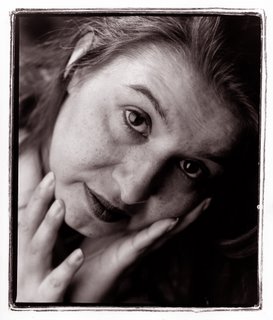
Bands of gypsies would occasionally come down my street when I was a child in Buenos Aires. They would ring our bells and offer to read our fortunes. As soon as we spotted the women with their ankle length dresses and colourful bandanas we would scurry inside the house. We had been warned by our mothers that gypsies robbed children. I was extremely afraid of them. Such was the power of prejudice.
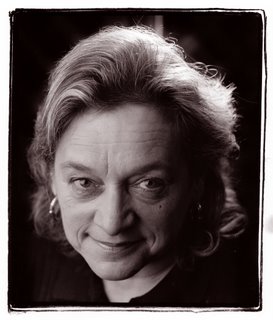
Alas I have no copy of that Straight so I cannot properly identify the people here. One of them, the sad man with his right hand by his heart was Lolo, a well known flamenco singer at the Kino Café. I remember going there to photograph him. At that time smoking was permitted and the Kino was one of the smokiest joints in town. The sad woman looking down centre, below, right is Julia Lovell.

I allowed my subjects to look into my camera and I did not give them much instruction. Yet most of them stared into my camera with what seemed an agony of suffering, many centuries long. Even when they smiled they smiled sadly. I am sorry that I cannot further dignify them with their name. On the other hand they overflow with it, dignity.
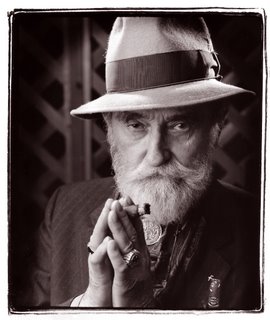
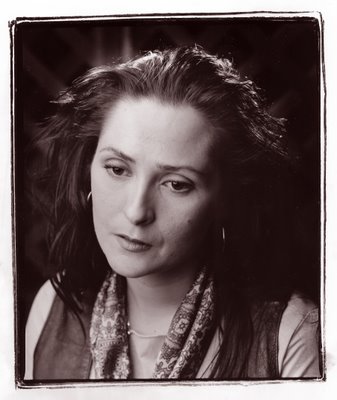
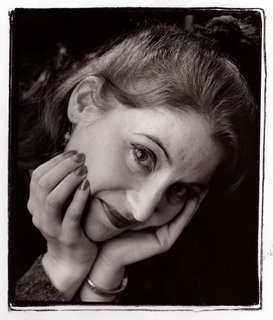

The Anguish Of Lavender
Wednesday, July 08, 2009

I have written here before on how I rarely listen to my music CDs and records. One of the advantages of increasing old age is that I hear them in my head. The little music I listen to is always live music at a concert. When possible I want that music to be baroque. When I drive to Lillooet with Rosemary and the two granddaughters I carefully choose the music. I don’t want to scare them with strange selections but I want to make them curious. In this way Rebecca has discovered Gerry Mulligan, Bach, Vivaldi, the Modern Jazz Quartet, Oscar Peterson and a beautiful tango CD with a quartet with Daniel Barenboim on the piano. Rebecca knows that Barenboim was married to Jacqueline du Pré. Thanks to Emily Molnar (see yesterday’s blog) Rebecca has a fondness for the solo piano sonatas of Philip Glass. We try not to play them on the way to Lillooet because Glass makes Rosemary nervous.
The music that I play for Rebecca (and eventually for Lauren when she shows more interest) is music that I can conjure with my virtual ears. I need not put the CD into the player to know what the music is like. Only yesterday I watched 20 minutes of one of the finest comedy scenes in all of film. This happens when Stewart Granger has to impersonate a clown (Scaramouche) to escape the nasty French cavalry captain that is after him. He manages to escape the captain to fall in the clutches and arms of the gorgeous flamed-haired Eleanor Parker. In those 20 minutes I realized I knew all the lines and that I can re-run the whole film in my head with Granger’s sonorous voice. I can imagine the pleasure of gazing on Parker’s many freckles beneath her Hollywood pancake makeup.
And so it is with smells. I can smell a sweet pea once every five years and that is enough to keep the “flame” alive in my memory. As I walked in today through my front gate after a tough day at photography school, I noticed a long row of Lavandula angustifolia. This is the most common and easiest lavender to grow in Vancouver. The trick is never to let it grow too woody. If you brutally prune it in early spring it comes back fresh every time. I did not stop to smell it.
Lavender with hints of Player’s Navy Cut and Old Smuggler Scotch (the Scotch that used to be made in Argentina long before the Japanese decided to make their Suntori Scotch) is what I could detect when I approached my father in his tweed jackets. When he kissed me I could smell the lavender which must have been Lavanda Inglesa Yardley since this brand was sold throughout Latin America. Hilary buys me a large container of Yardley Lavender talc and a carton of four soaps every couple of Christmases. Both she and Rosemary always have large supplies of Lavender bath salts for me.
I have never told them that my attraction to lavender has all to do with that tiny part of me that is still English. It is that tiny part that makes it imperative that I begin my day with an extremely strong and extremely large mug of tea made with the finest tea leaves I can purchase. It is this English in me that had me straddling the fence when the British fleet was steaming toward the Falklands and the Hand of God vanquished the British soccer team.
My father spoke English like an Englishman even though he had been born in Buenos Aires. His father Harry was from Manchester and so was his mother Ellen Carter. Because of my father I was called el inglesito (the little English boy) by our neighbours. Because of my father, lavender, Player’s Navy Cut tobacco and that hint of scotch is a smell that I cannot ever remove from my psyche.
It was my mother who often told me (she didn’t much praise me) that I had the pleasant smell of an Englishman. I never questioned her since I didn’t smoke Player’s Navy Cuts or drink Scotch. But I threw in the towel and adopted lavender as part of my life even if I don’t (and I don’t ) splash it on as my father must have. My mother used to hug me and smell me behind the ears. “Olés como un ingles,” she would say to me. She told me that Eskimos (she had no inkling of the existence of the Inuit) never kissed by rubbed noses and smelt each other. She said this was far more civilized. She explained how the civilized French had invented exquisite perfumes to hide the hideous smell that all the French had as part of their nature. My mother, while born in Manila, did always like her things English and therefore looked down on the French. She not only thought my father was handsome but she would cite other English on her list of favourite men, actors like Ronald Colman, Herbert Marshall and her favourite of favourites, Leslie Howard. And, yes, Stewart Granger.
When I married Rosemary in Mexico City and then told my mother that she would soon be a grandmother she made it a point to insist, “Make sure that the baby is born at the American, British Cawdry Hospital. That made me smile. While in the clutches of the Argentine Navy I found various ways of thwarting my superiors’ demands that I be at my post at a certain hour and that I must report to work Monday through Friday.
On my way to my post I would arrive at the imposingly British train station Retiro (not really a replica as the British themselves had engineered it and brought the materials for it) in the 8:37 train from Tigre. The British loved to have trains arrive exactly on time at odd numbered minutes! I would then go to the station master (very Argentine in spite of his very British uniform) and explain what I needed. After a while I did not have to explain and he would hand me the sheet with his official stamp and signature. I didn’t abuse this trick too often as I could have gotten caught. The document in question stated that the train had been delayed by a derailment and had arrived at Retiro one hour late. This gave me time to go to the venerable Retiro restaurant and tea shop. It was and is beautifully wainscoted and the windows all have beveled edges and the chandeliers are all of cut glass. I would then order from the properly dress waiter a café con leche with medias lunas de grasa (exquisite croissants made from lard and which are extraordinarily chewy) which I would dunk in my coffee after slathering them with Argentine unsalted butter and strawberry jam. The Teniente at the office would look at my Retiro certificate and say, "This country went to hell when the English left. Now even the trains don't arrive on time."
The other “trick” was to donate blood. The Naval Book of Military Regulations stipulated that the naval conscript who donated blood could have the next day as a holiday if the proper certificate were shown. In the afternoon of a Thursday (as a perfect example on how well this trick worked) I would go to the British Hospital to donate blood. After looking away during the process ( I faint at the slightest hint of the shiny red stuff) I was told to rest for a while and then I would be served a “té completo”. This was tea, sandwiches and scones with marmelade and clotted cream. With certificate in hand I would go back to my office and hand the document to Cabo Moraña. He was a corporal in the Argentine Marine Corps who appreciated my tricks as long as I didn’t go over his head. And I would then enjoy a three-day weekend.
The folks at the British Hospital served me well even though they restricted my blood donations to every two months.

Somehow as I walked by the lavender today I wondered why it is called angustifolia. In Latin this means narrow-leaved. That is correct as the leaves of this lavender are particularly long and narrow. But I also think of the Spanish word angustia (or anguish) and wonder if the Latin root is the same. A check with my on line Royal Spanish Dictionary confirms it. A tight space or situation produces anguish. In order to keep that memory of my father alive I just need to have Lavandula angustifolia near at hand. I don’t have to smell it. It is enough to know that it is there. And so is my father. That is comforting.
Long Live The Queen
Tuesday, July 07, 2009

No hay mal que por bien no venga.
Spanish Proverb
Bad stuff happens so good things can, too.
It was with pleasure that I read today in my Vancouver Sun that dancer/choreographer Emily Molnar has been named interim artistic director for Ballet BC.
There is no doubt in my mind that John Alleyne’s tenure as artistic director was a positive one for Ballet BC. When he first started I remember seeing an old-fashioned ballet that featured May pole dancing! At the time the audience was made up (more than now, I believe) of conservative old ladies who just loved their Giselles, Nutcrackers and anything else by Tchaikovsky. Slowly (but fast enough for me) without those little old ladies noticing it, Alleyne got rid of the May poles and incorporated the avant-garde choreography of former Frankfurt Ballet director William Forsythe adn wonderful stuff by National Ballet of Canada Artistic Director James Kudelka. Alleyne himself brought in his own choreography. A lot of it had as its cornerstone the dancer Emily Molnar whom he had lured home from Ballet Frankfurt in 1998.
When Molnar (she is striking at 5 ft 11in) entered my studio for her first picture in 1998 she quietly sat in a corner in a fetal position for 10 minutes before facing my camera. Since then, thanks to Molnar, and the performances of some of William Forsythe’s works by Ballet BC I have come not only to appreciate why Forsythe’s choreography and his company were rated about best in the world but also why Molnar can talk physics. Asked on how he pushes the boundaries of the form of dance Forsythe once said, “I don’t think so much of the body when we are doing this. We are thinking about ‘the thinking body’ or we’re trying to understand how the body thinks about its own presence.” Or the way the ever-succinct Molnar put it to me, “Dance requires the entire body and the mind.” And she ventured into Einsteinian ephemera when she discussed space, time and movement in my studio (with her former Frankfurt Ballet soul mate Crystal Pite, note picture here).
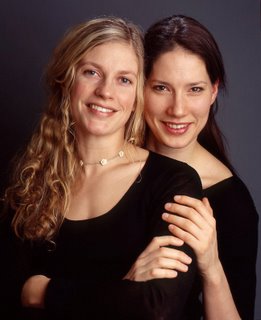
The shortest definition of relativistic movement I have ever heard came from Molnar and Pite. Molnar said, “Movement is the observer.” This means that from a position of rest we the observers can discern the movement of a dancer on stage. Of time Pite said, “The ephemeral of dance exists only in the present movement. We are left with traces of movements that are gone as they are being created. As we carve space with our bodies they leave a ghost, the trail which affects our future moves and informs the observer of our past moves.” I then understood that those past moves are much like the contrails that high-flying jets leave in the sky.
Molnar has her own company, Emily Molnar Dance. When possible I have attended whatever performance of hers I can find. More often than not she is busy choreographing for companies in Europe and New York. I sometimes catch her rehearsing the senior dancers at Arts Umbrella on Saturdays. Her principal role performances for several of John Alleyne’s full-length works included The Faerie Queen and Scheherazade linger in my memory. On the rehearsal of the latter Rebecca first noticed her and insisted on meeting her. It was in Molnar’s solo performance of Speak choreographed for her by Margie Gillis that I finally fell hard for her. I had to photograph Molnar for the Straight so she offered to go through the whole performance (just for me!) so I could pick a dance move for the photograph (one of the pictures is the one here). In such close proximity I learned how strenuous dance really is, no matter how effortless a dancer makes it seem to be. I now sit in the front row for dance performances, as part of the rewards of watching dance is to be able to hear the dancers breathe.
Every time that I have been to a Molnar performance, Rebecca has had the opportunity to chat with her after. I have no idea what it is they talk about but some of these conversations are long. On several occasions Rebecca and I watched (from a window) Molnar’s master classes at the Arts Umbrella. Not long after Rebecca told me, “Let me show you some Molnar moves.” It was uncanny she seemed to be a little Emily Molnar! Rebecca had distilled some of the very moves that make Molnar a one of a kind in dance.
Having observed how Molnar handles children, teenagers and near adults at Arts Umbrella I can assert gracefully and reverently say of John Alleyne (as far as Ballet BC is concerned), “The king is dead, long live the queen!”
A new and exciting era is upon Ballet BC.
My debt to Ballet BC
La Muchacha De La Cochinchina
Monday, July 06, 2009

My Sevillan grandmother would have said, “She has the map of Jerusalem on her face.” In retrospect I can see what drew me to Madeleine when I first spotted her face – the pale skin made even whiter by the contrast with her red lips – in the summer of 1985.
As a boy growing up in Mexico City, I would stare at the darkish faces yelling a strange archaic Spanish from the inside or the orange school bus that passed by every day. On its side was the enigmatic message “Colegio Hebreo Sefardita”. Ever since Sefardites, or Spanish Jews, have been a mixture of the exotic and the mysterious to me.

Madeleine’s face is a magician’s ball in which apparitions of the past hover and dance for me. In the deep shadows behind her eyes, I see the little girl peering out from the left corner of El Greco’s The Burial of the Count of Orgaz, hanging in the church of Santo Tomé in Toledo. In the noble lines of her cheekbones l see her ancestors praying in a tiny white synagogue in Granada. Nearby, in an ornate cathedral, lie the tiny lead caskets of the Catholic Kings who would exile them forever from Spain in 1492.
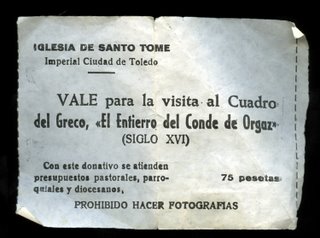
Madeleine was raised in Spain, and she always makes it a point to remind me of the source of her power over me in her throaty and impeccable Castilian. As I photographed her in her tub, she said, while carefully pulling down the top of her yellow and black ‘50s bathing suit, “I had to wear something, after all. It has to do with my Jewish sense of morality.”

Things have changed for Madeleine since I last photographed her in 1985. She now lives in Vietnam where she has somehow superseded her Jewish sense of morality. She writes:
I live in exile in southern Vietnam, where I do my level best not to disgrace my family by staying as far away from them as possible. However, once a year or so, I just can't help myself; I make the trek back to England.
I live in a small house with a giant mango tree in the front yard and a cat called "Seven". In the back, I have a covered orchid garden, which I tend to with an obsession that most people would consider unhealthy. I find that orchid growing and sex have a great deal in common. I hold a masters in writing and am agonizing over a PhD. This has made me a good deal more critical about my own writing and, sadly, less productive.
Ron Basford, John Turner - Redux
Sunday, July 05, 2009
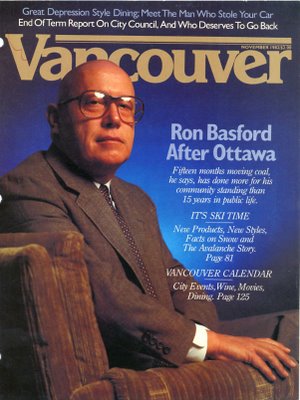
I do believe that there are no new ways of doing things. One just repeats what has been done before with minor personal modifications. At least this is what I try to impart to my photography school students. In the last month I have been looking back at some of my stuff and trying to put a handle on how one of my present students would have approached the same assignment had they been around with the difference of having a present day mentality.
Every time I go to Granville Island and I enjoy my cup of tea at Granville Island Tea Company I remember the one man singly responsible for making the Island the success it is. It was a Vancouver politician, Ron Basford, who was a cabinet minister for Pierre Trudeau in the 70s and I believe in the very early 80s. The fact is that when Mr. Basford was about to pose for me in his office for a Vancouver Magazine November 1982 cover we were interrupted by a phone call from Pierre.
When I had faced Basford earlier that day I was shocked to find he had no hair anywhere on his face, no eybrows, not eye lashes. I also notice his huge glasses (the problem of reflecting my light umbrella on it) and his shiny bald head. He also had a prominent double chin. I could not give art director Rick Staehling any excuses for any failure on this cover assignment and editor Malcolm Parry, a very good photographer himself, would not have shown any sympathy if I messed this one up.
I asked the receptionist if anybody in the office might have powder to dull the sheen on Basford’s head. Her negative reply made me sink even more in my depression with the indication that I was doomed. I happen to look at the coffee machine behind the receptionist’s desk and I noticed something. I picked the jar up and took it to Basford’s office. I decided to call the spade a spade and I asked Basford, “Sir can I use this Coffee Mate to take the shine off the top of your head? “ His answer was immediate, “If it will do the job, go right ahead.”
Two years later I was working on the photographs for a Vancouver Magazine article called Top Drawer. I told Mac Parry , “If this article is about the movers and shakers of Vancouver why don’t we put our Prime Minister on the cover? After all his riding is somewhere on the Sunshine Coast. He may not be from here but he has parachuted here and should be in our list.” Mac told me, “Get him.”
That became a nightmare. John Turner was prime minister but he had called elections and was running for the job as incumbent. His campaign manager (an extremely rude man) told me that Turner did not have time to pose for a city magazine as he was too busy shaking hands with his constituents. I explained that the cover with Turner on it would appear a week before the elections and it woul help at least in Vancouver to get him more votes. The campaign manager simply hung up.
Feeling desperate I had an idea. I called Ron Basford early one morning. In 1984 he was in Ottawa again. His secretary told me to wait a bit. Basford was on the line and I explained the problem. “Alex let me take care of it he said. What is your phone number?"
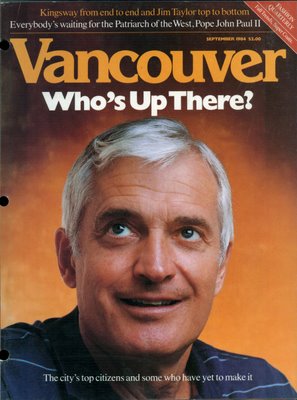
That evening I received a call from Turner’s office: “Mr. Turner will pose for you at the Hotel Vancouver tomorrow morning after his tennis practice.”
Addendum:
My blog has a most efficient built-in search engine. I searched to see if I had already written about Ron Basford. I had! But I will try to prove my point here that there is no new way of doing things. You just keep repeating them with slight variations! The original is here. It is more elaborate as it includes Audrey Hepburn.
An Afternoon At South Arm Pool Brings Memories Of A Quiet Past
Saturday, July 04, 2009
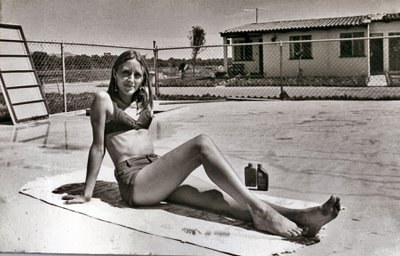
After lunch of homemade pizza Rosemary and I took the two girls to the South Arm Pool in Richmond. The pool has a couple of water slides. Rebecca and Lauren were looking forward to it. Rebecca has passed her Aquaquest 9 and her instructor says that Rebecca has grace no matter what swimming stroke she does. Lauren passed Aquaquest 1 and still insists on using a floating vest in the water. But both love being in the water. As I watched the crowds, some were playing Frisbee, others were screaming in the water and young girls in bikinis were experimenting with getting glances from young boys. I could not understand how we had been persuaded to come to the place. But there was a comforting familiarity which I cold not pin down until we were driving home.
Sometime in the early 70s while living in Mexico City we discovered a way of avoiding swimming pool crowds on hot summer days. We would drive with our young daughters Ale and Hilary to a KOA (Kampgrounds of America) that was not too far (about an hour away) from our house. We would check in and pay for a day’s stay. This gave us access to their swimming pool which we always enjoyed in what now really seems like a luxurious privacy. In the pictures you can see Rosemary, about 28, and Ale, 5, on the swing. There were no water slides but this was amply compensated by the stark and peaceful quiet of the Mexican sierra. To be fair, with the advent of iPods, there were next to no loud ghetto blasters today at South Arm Pool. While drying in the sun I was hit several times in the head by errant Frisbees. Frisbees have changed. These were the size of a pizza dish.

While attempting to swim in a pool that seems to have no deep end ( public parks in no-fun-let’s-always-be-safe Vancouver have eliminated deep ends, slides, and have now banned mothers from taking their children down the water slides together) I counted the hundreds of young children there. I wondered (I inherited this from my Tío Luís Miranda who hated beaches because he said sand got into his shoes) how many were too lazy to go to the bathroom in the designated location?
Yet sacrifices have to me made and in the end it was all worth it as I watched Rebecca and Lauren laugh. I even spied the usually somber Rosemary smiling here and there.
Falstaff In The Focative Case
Friday, July 03, 2009
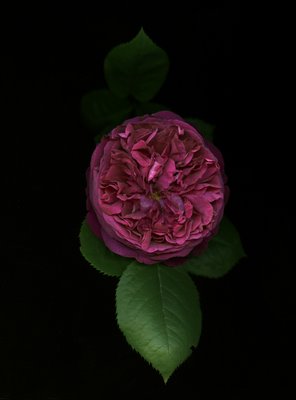
For once Rebecca, Rosemary and I agree on something about the garden. The three of us have gone nuts for old roses that are red or crimson. We are particularly into the once-blooming Gallicas (including our fave ‘Charles de Mills’) as they have the peculiarity of fading into beautiful purples, gray blues and sometimes a metallic blue. So when we find roses that fit all those requirements (including, of course a strong old rose scent) plus the plant in question is remontant (Rebecca would tell you that it means that the rose bush in question re-blooms throughout the summer) we are in rose heaven. We already have in the garden David Austin’s beautiful ‘William Shakespeare’. This rose was supposed to be a dud so Austin took it out of the market and introduced an improved version with the unpoetic name of ‘William Shakespeare 2000’. The fact is that with some tender and loving care my ‘William Shakespeare’ is doing just fine right next to a new plant (new in our garden this year) ‘William Shakespeare 2000’.
It was last year at the Vancouver Rose Society’s rose show at VanDusen that both Rebecca and Rosemary spotted a English Rose that somehow had escaped my notice. It was a beautiful crimson ‘Falstaff’. This year I ordered a plant and plunked it into the garden. Note the scan of one of the blooms that I cut this afternoon.
This spring Rebecca told me she, too, wanted ‘Falstaff’. Her father had told her that unless she took care of her plants she was not to have any more roses in her plant-in-pot garden. I did not pursue the matter and now it seems that Rebecca has developed a renewed interest in taking care of her plants and she is most proud of them. One day Rebecca went to Southlands with her other grandmother and spotted ‘Falstaff’. Rebecca checked her pocket and she needed some more money to buy her plant. I suspect that her grandmother saw this as a child’s passing fancy so she did not add to Rebecca’s money pot and the rose was not purchased. She must have made a loud fuss on how fantastic the plant was because when I returned the next day to buy it for her it had been sold.
There is one consolation here for Rebecca and that is that Rosa ‘Charles de Mills’ is a rose that sends underground runners. My ‘Charles de Mills’ has two ancillary plants. One of them is in bloom with many flowers. Rebecca knows that when the plant is semi dormant in the fall I will dig it out and the plant will be hers.
As I brought in ‘Falstaff’ to scan it I thought of one of my favourite books by Anthony Burgess. Burgess seems to be a an author who was underappreciated when he was alive. Perhaps it had to do with the fact that he was a prolific author. The book in question is called 99 Novels – The Best in English Since 1939. The book ends with Norman Mailer’s 1983 Ancient Evenings and it starts with Henry Green’s Party Going.
The bringing in of ‘Falstaff’ brought to mind 1976 as Burgess lists for that year, Robert Nye’s Falstaff.
This is what he writes about the book which I will have to now find at the library.
François Rabelais presents characters, even though some of them are giants, and events, even though many are implausible, and so may be considered a novelist. Joyce was influenced by him, and in many post-Joycean novelists the urge to expand fiction Joyceanly is really a desire to return to Rabelais. Robert Nye has stolen Shakespeare’s Falstaff, unrelating him to the historical original, and, as it were, unbuttoned him. He becomes her more than a witty exemplar of gorging and philosophical cowardice; he is turned into a god of fertility. A chapter entitled “About Sir John Falstaff’s Prick” is wholly Rabelaisian with its bawdy catalogue, though Rabelais would have gone much further. However much we long to be back Pantagruel and Panurge, we cannot lose all our inhibitions. Nye is occasionally facetious - “Buckram,” Falstaff says to Hal, “becomes you. It goes with your eyes” - but on the whole he combines, very successfully, the forward drive of modern fiction with the wordy divagations of a more monkish tradition. His Falstaff cannot be greater than Shakespeare’s, but the whole sprawling portrait is a relevant gloss on Shakespeare as well as a restoration of Falstaff to his true historical context (Shakespeare’s Falstaff is post-Reformation sceptic; Nye’s is a backsliding Catholic) and the erotic candour is of our own time.
The lovely focative sucking over, just this side of emission, she’d let my engine out of her spiced trap – (Mrs Nightwork was a great one for eating garlic and cloves.) Then she’d press my prick to her cheek, which was usually cool as cream. She had a trick of fluttering her eyelashes upon the delicate skin just below the head, where the foreskin puckers, which I find delicious…
This book was a bold venture and an indication of what the novel can do when it frees itself from the constraints of the Jamesian tradition.
----------------------------------------------------------------------------------------------------------------------------------
As for those who may want to explore the meaning of the word focative:
The Focative Case
Shakespeare, The Merry Wives of Windsor, IV.1.42-46:
Sir Hugh Evans:
What is the focative case, William?
William Page:
O,—vocativo, O.
Sir Hugh Evans:
Remember, William; focative is caret.
Mistress Quickly:
And that's a good root.
Focative (a pun on the f- word), caret (i.e. carrot = membrum virile), and root (membrum virile), but also in O, which he connected with ring and circle (all three to him signifying pudendum muliebre).
I leave it to any of my blog readers to pursue pudendum muliebre. And, yes, there is a David Austin English Rose called 'Mistress Quickly'.
Alain Blanchard Waits And Lisa Poses
Thursday, July 02, 2009
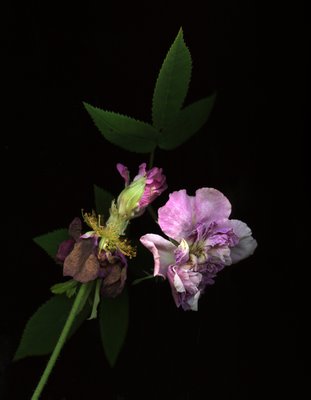
I first photographed the Vietnamese/Canadian Lisa Ha in June 2001, below, right. I then photographed her in Feb 2004. Today she posed for me in my studio. I asked her how old she was. She told me she was 33. One of the few fringe benefits of my profession is to photograph people over and over and be able to watch gentle (in the case of Lisa Ha) march of time. Perhaps I will photograph her a few more times before I hang up my cable release.
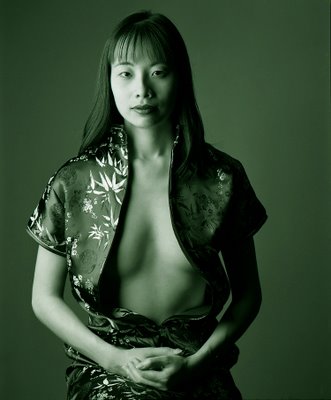
Unfortunately few women will allow themselves to be photographed beyond a certain age. I know I cannot approach a woman and tell her, “I am fascinated by the beautiful over the top decay of my garden in the fall. How would you like to pose for me?” I would receive, at the very least, a slap. And yet there is beauty in decay.
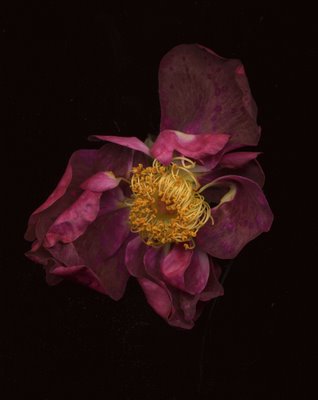
As I left for Texas on June 10 my mottled roses Rosa ‘Alain Blanchard’ and Rosa ‘Soleil Brilliant’ were about to bloom. I felt sad that I would not see them in their prime. The fact is that when I returned June 18 they were going strong. Today I have cut off what is left of Alain Blanchard and I show here (the first one is from today) with two other images I took of her June 20, 2007. At her best Alain Blanchard has these spots on her petals. People who don’t know think that somehow this Gallica rose has suffered rain damage. But in fact a few of us appreciate the odd beauty of the marbled look. And a few of us also appreciate the beauty of over the top decay.

Oh Canada!
Wednesday, July 01, 2009
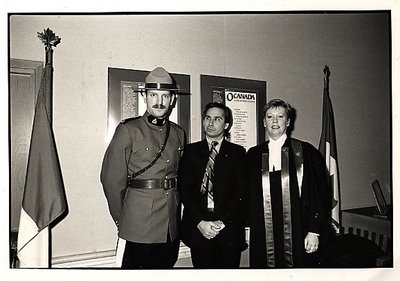
When I met Rosemary in Mexico City in 1968 I knew nothing of Canadians. In fact I used to think Canadians as “non-Americans”. The few I had met before Rosemary, were always correcting people and saying, “I am not an American, I am Canadian.” It seemed to me that Canadians were quite sure of what they weren’t. From Rosemary I learned to pronounce Quebec as Kebek and she had the quaint custom of saying “When I was in grade 9...” To my ears it sounded odd. Rosemary made me aware of Pierre Trudeau and that he was sexy even though the only other sexy Canadian I have ever met was Rosemary. I liked Rosemary in particular because of her precise English that did not sound American. It was almost a British English.
My other knowledge of Canada was listening to my Grandmother Lolita tell me how in the late 20s they had taken a Japanese ship from Manila to a place that had mountains and tall trees. She pronounced the place “bancoober”. She told me of a huge train station (the CP Station) where she, my mother, her son Antonio and the other very young daughter Dolly had taken a train to Montreal and from there another to New York City.
When I had met Rosemary I had a confused sense of national identity. I had gone to do my military service in Argentina and a moment of tearful patriotism when I had sworn allegiance (with thousands of other sailors) soon became one of disappointment and cynicism. I had been ordered to participate in a coup where the armed forces removed our legally elected president.
In Mexico, in 1968 there had been a massacre of students at Tlatelolco. I talked like a Mexican but I did not feel like one. If anything my four years in a Texas Catholic boarding school had left its mark and I felt quite American. Like most Argentines I wore Levis and only wore button down shirts. I only listened to 60s American jazz and read only in English. Most of the books were by American authors.
When we arrived in Canada in 1975 with our two daughters my first confusion was running into Mexicans who did not seem to understand my Spanish. Rosemary told me that these “Mexicans” were really Native Canadians. It was then that I realized that the old dictum that had been drummed into me at school about the red Indian and the yellow race of the Orient was all a sham.
About 15 years ago I learned to dance the Argentine tango and I made friends with an Argentine couple Juan Manuel Sanchez and Nora Patrich. We would “matear” or drink mate almost every day. I began to read in Spanish. Suddenly I had a deep nostalgia for Argentina. I returned a couple of times but somehow I didn’t feel I fit there. I felt like a hybrid. I was a bit of everything. I was an everything that did not add up to anything. I was a landlubber Edward Everett Hale, The Man Without A Country.
I had to become a Vancouverite before I could be a Canadian. That happened some years ago when I participated in a photographic show of architecture of our city. It was sponsored by the UBC School of Architecture which had opened a city branch by the Dominion Building. I looked at my pictures on the wall. They were up there with pioneers of such as Otto Landauer and Leonard Frank. These two men had photographed Vancouver from its inception. I was up there, too! This had to be my city. I left the show with the excitement that after almost 28 years in Vancouver (the show may have been about 11 years ago) I was no longer a tourist.
I was from here.
Canada rapidly adopted me without much fuss and too much paper work. Canada made me feel at home and fed me the addictive drug that is efficiency, 110 volts that are mostly unwavering and comforted me with the realization that I could lose my driver’s license but be able to get a replacement in minutes with no fuss. I took it for granted that the gas I put in my car was not diluted with water and except for the few times I was caught speeding I never felt and fear about being stopped by a cop. And every year, year after year I received and have received all 12 issues of the National Geographic. Except for the odd postal strike, the mail works!
I feel nostalgia for Argentina and I feel nostalgia for the colours, the heat and the ancient churches of Mexico. But what I feel for Canada seems to be more serene. It is a calming realization that I live where I belong and I belong here where I live.
Photo above by Robert Blake.






